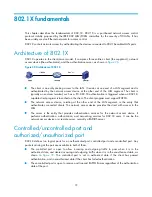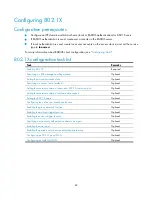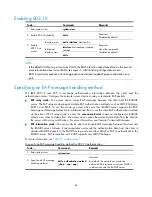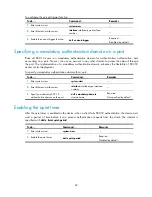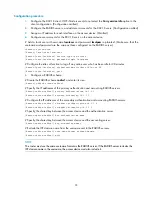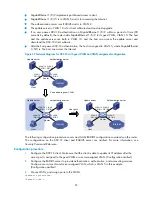
85
Setting the maximum number of concurrent 802.1X users on a
port
Set the maximum number of concurrent 802.1X users for one port in interface view or for multiple ports
in system view. If different settings are configured for a port in interface view and system view, the
setting configured later takes effect.
To set the maximum number of concurrent 802.1X users on a port:
To do…
Command…
Remarks
1.
Enter system view.
system-view
—
2.
Set the maximum
number of
concurrent 802.1X
users on a port.
In system
view
dot1x
max-user
user-number
[
interface
interface-list
]
Optional.
Use either approach.
The default maximum number
of concurrent 802.1X users is
1024.
In Ethernet
interface
view
interface
interface-type
interface-
number
dot1x
max-user
user-number
[
interface
interface-list
]
Setting the maximum number of authentication request attempts
After the network access device sends an authentication request to a client, if the device receives no
response from the client within a period of time (specified by
dot1x timer tx-period
tx-period-value
or
dot1x timer supp-timeout
supp-timeout-value
), the device retransmits the authentication request. If the
number of transmission attempts exceeds the specified upper limit but the device still receives no
response, it stops transmitting the request.
To do…
Command…
Remarks
1.
Enter system view.
system-view
—
2.
Set the maximum number of attempts for sending an
authentication request.
dot1x retry
max-retry-value
Optional
2 by default
Setting the 802.1X timers
The network device uses the following 802.1X timers:
•
Username request timeout timer (
tx-period
)—Starts when the device sends an EAP-Request/Identity
packet to a client in response to an authentication request. If the device receives no response
before this timer expires, it retransmits the request. The timer also sets the interval at which the
network device sends multicast EAP-Request/Identity packets to detect clients that cannot actively
request authentication.
•
Client timeout timer (
supp-timeout
)—Starts when the access device sends an EAP-Request/MD5
Challenge packet to a client. If no response is received when this timer expires, the access device
retransmits the request to the client.
•
Server timeout timer (
server-timeout
)—Starts when the access device sends a RADIUS Access-
Request packet to the authentication server. If no response is received when this timer expires, the
access device retransmits the request to the server.


